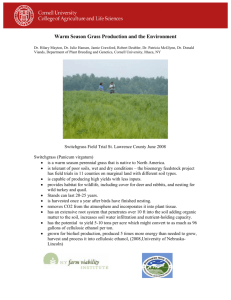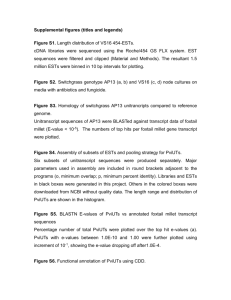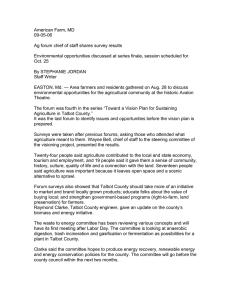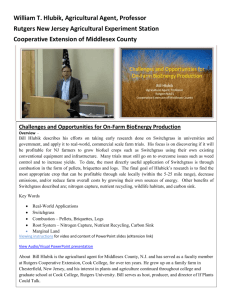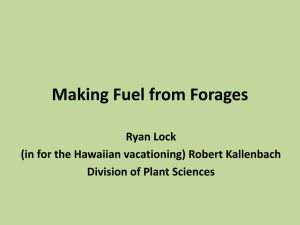T Estimated Costs for Production, Storage and Transportation of Switchgrass File A1-22
advertisement
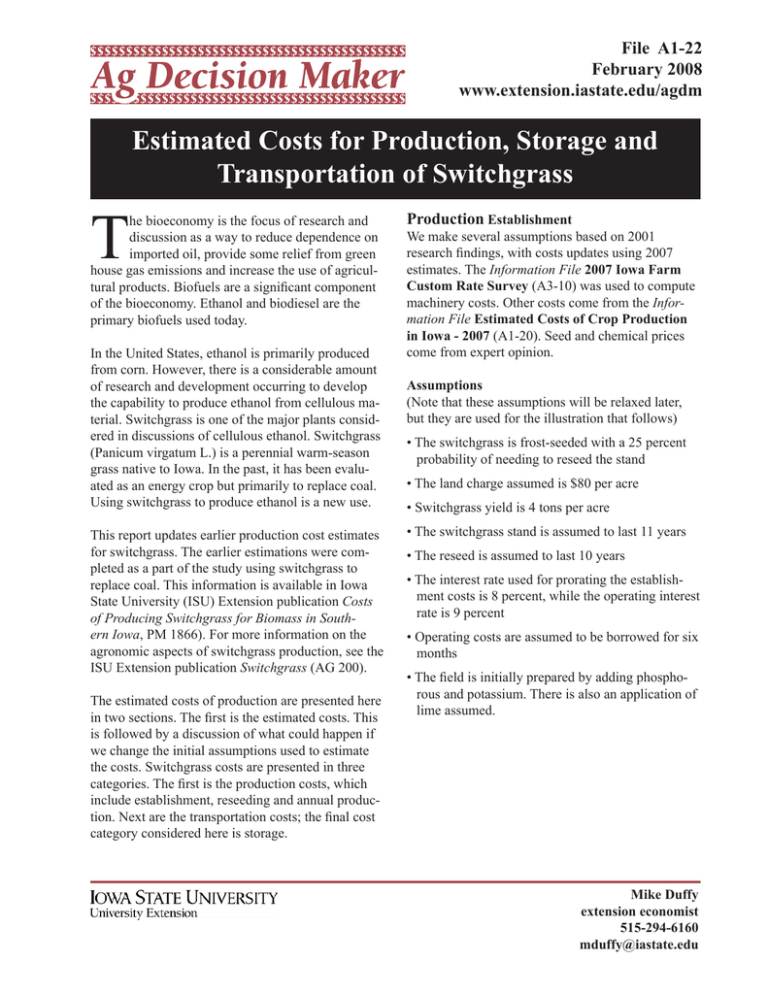
File A1-22 February 2008 www.extension.iastate.edu/agdm Estimated Costs for Production, Storage and Transportation of Switchgrass T he bioeconomy is the focus of research and discussion as a way to reduce dependence on imported oil, provide some relief from green house gas emissions and increase the use of agricultural products. Biofuels are a significant component of the bioeconomy. Ethanol and biodiesel are the primary biofuels used today. In the United States, ethanol is primarily produced from corn. However, there is a considerable amount of research and development occurring to develop the capability to produce ethanol from cellulous material. Switchgrass is one of the major plants considered in discussions of cellulous ethanol. Switchgrass (Panicum virgatum L.) is a perennial warm-season grass native to Iowa. In the past, it has been evaluated as an energy crop but primarily to replace coal. Using switchgrass to produce ethanol is a new use. This report updates earlier production cost estimates for switchgrass. The earlier estimations were completed as a part of the study using switchgrass to replace coal. This information is available in Iowa State University (ISU) Extension publication Costs of Producing Switchgrass for Biomass in Southern Iowa, PM 1866). For more information on the agronomic aspects of switchgrass production, see the ISU Extension publication Switchgrass (AG 200). The estimated costs of production are presented here in two sections. The first is the estimated costs. This is followed by a discussion of what could happen if we change the initial assumptions used to estimate the costs. Switchgrass costs are presented in three categories. The first is the production costs, which include establishment, reseeding and annual production. Next are the transportation costs; the final cost category considered here is storage. Production Establishment We make several assumptions based on 2001 research findings, with costs updates using 2007 estimates. The Information File 2007 Iowa Farm Custom Rate Survey (A3-10) was used to compute machinery costs. Other costs come from the Information File Estimated Costs of Crop Production in Iowa - 2007 (A1-20). Seed and chemical prices come from expert opinion. Assumptions (Note that these assumptions will be relaxed later, but they are used for the illustration that follows) • The switchgrass is frost-seeded with a 25 percent probability of needing to reseed the stand • The land charge assumed is $80 per acre • Switchgrass yield is 4 tons per acre • The switchgrass stand is assumed to last 11 years • The reseed is assumed to last 10 years • The interest rate used for prorating the establishment costs is 8 percent, while the operating interest rate is 9 percent • Operating costs are assumed to be borrowed for six months • The field is initially prepared by adding phosphorous and potassium. There is also an application of lime assumed. Mike Duffy extension economist 515-294-6160 mduffy@iastate.edu File A1-22 Page 2 Table 1. The estimated costs of establishing the switchgrass, presented in dollars per acre. Land charge Preharvest machinery operations custom charges Disk Harrow Airflow spreader (seed and fertilizers) Spraying chemicals Total Operating Exp. Price/unit Units Seed $7.50/lb 6 Fertilizer P $0.37/lb 30 K $0.23/lb 40 Lime $21/ton 3 Herbicides Pursuit + $53/gal 3 oz MSO $1.75/pt 32 oz 2,4D $16/gal 1.5 pts Total operating costs $80.00 $9.45 6.25 7.70 5.15 $28.55 $45.00 11.10 9.20 63.00 1.24 3.50 3.00 $136.04 Total establishment $244.59 11 years at 8% amortization (.14008 factor) Prorated yearly establishment Cost per acre $34.26 It is assumed that a field needs to be reseeded 25 percent of the time. Basic ground preparation and lime are not included for the reseeding. Table 2. The estimated reseeding costs per acre. Reseeding probability Land charge 25% $80.00 Preharvest machinery operations custom charges Airflow spreader (seed and fertilizer) Spraying chemicals Total $7.70 5.15 $12.85 Operating Exp. Price/unit Units Seed $7.50/lb 6 Fertilizer P $0.37/lb 30 K $0.23/lb 40 Herbicides Pursuit + $53/gal 3 oz MSO $1.75/pt 32 oz 2,4D $16/gal 1.5 pts Total operating costs Total reseeding costs Expected reseeding costs (25% probability) Prorated yearly establishment Cost per acre $45.00 11.10 9.20 1.24 3.50 3.00 $73.04 $165.89 $41.47 $6.18 10 years at 8% amortization (.14903 factor) Assumptions • A 4 ton per acre yield. • 100 pounds of nitrogen (N) is used. The herbicides listed are examples. Phosphorus and potassium are at removal rates. • Harvesting is done in mid to late November. It will be mowed, raked and baled, using a large square baler. Bales are 3x4x8 feet, with a weight of 950 pounds. • The bottom of Table 3 also presents the total estimated costs for producing switchgrass. Production costs are the sum of the establishment costs, the prorated reseeding costs and the annual production costs. Page 3 File A1-22 Table 3. Estimated yearly production costs per acre. Expected yield per acre Weight of large square bale Bales per acre 4 tons 950 lbs 8.42 Land charge $80.00 the enclosed building is the most expensive type of storage, but, because maintaining quality of switchgrass is very important for ethanol production, it is the method selected here. (Note that if switchgrass is used as a coal replacement, the quality consideration is not as critical and another storage option might be considered.) Preharvest machinery operations custom charges Liquid N application $4.80 Bulk fertilizer spreader 3.20 Sprayer 5.15 Total $13.15 The costs of storing include not only the cost for the facility or method used but also include the value of the switchgrass in storage and dry matter loss associated with the various storage methods. Operating Exp. Price/unit Units Fertilizer Nitrogen $.31/lb 100 Phosphorus (lbs/ton removed) .37/lb 1.94 Potassium (lbs./ton removed) .23/lb 22.8 Herbicides Pursuit + $53/gal 3 oz MSO $1.75/pt 32 oz 2,4D $16/gal 1.5 pts Total The estimated storage costs are presented in Table 4 for an enclosed building. (These cost assumptions are relaxed in later discussions.) Interest on operating expenses, 6 mo. @ 9% $31.00 2.87 20.98 1.24 3.50 3.00 $62.59 $3.41 Harvest machinery operations, custom charges Mow/conditioning $10.75 Rake 5.30 Baling: large square ($10.70 bale) 90.11 Staging ($2.75/bale) 23.16 Total $129.31 Yearly production costs per acre Prorated establishment cost Prorated reseeding cost $288.46 34.26 6.18 Production costs per acre Production costs per ton $328.91 $82.23 Storage Previous studies estimated the costs for storing switchgrass. The options considered include storing in: an open field, an open field on crushed rock covered with a tarp, an enclosed structure, and a pole building with open sides. These studies found that Since there are various types of enclosed buildings, we make several assumptions. Assumptions • The structure is a tarped hoop type structure and holds 5,454 bales or 2,591 tons. • Assume a cost of $12 per square foot for the finished building. • Dimensions are 100x300 feet (30,000 square feet). • The bales weigh 950 pounds or 0.475 tons and are 3x4x8 feet. • The bales are stacked 20 feet high or six bales high. • The building and area are assumed to take two acres. The extra space is for building edging, driveways and turnaround space for semi-trucks. One issue that is not addressed is who owns the switchgrass while it is in storage. This aspect of the cost of production has not been decided. Therefore, we chose not to estimate it. There are at least two major costs that are not considered because of this decision. First, there is the value of the switchgrass over the time it is in storage. Second, and perhaps more important, is the insurance for the switchgrass and building. Storing this much dry hay could create a fire hazard. File A1-22 Page 4 Table 4. Storage. Table 5. Transportation and handling costs. Building costs $12 per square foot $360,000 Field to storage costs: 5 miles to storage at 25 miles per hour: Yearly costs: Land, 2 acres Building: yearly ownership cost at 12% Storage cost per ton $160 $43,200 $16.67 Transportation and Handling Truck costs Load .5 hour; unload .33 hour, travel .4 hour 1.23 hours x $70 $86.33 Transportation and storage logistics will vary depending on the situation, so again, we make some assumptions. Loader costs (labor, tractor and fuel) ($12 + $20 + $10.78 = $42.78/hour) 0.83 hours x 42.78 $35.65 Assumptions • For these estimates, the switchgrass bales are staged along the edge of the field. This cost is included in the production budget. A farmer with a typical tractor and bale fork can perform these duties. Total hauling cost to storage $121.98 Transportation to storage cost per ton $6.10 • Another transportation cost is collecting, delivering and unloading the bales into a storage facility. A semi-trailer holding 20 tons (or 42 bales) is used to haul the switchgrass. Estimated times are 30 minutes to load the truck and 20 minutes to unload. The charge for the semi is $70 per hour. • A typical tractor and bale hauler will not work to stack large square bales 20 feet high. More specialized equipment is needed for this task. Estimated costs of such a tractor were $20 per hour and $10.78 worth of fuel per hour. The operator charge is $12 per hour. Table 5 shows the estimated transportation costs. These are shown in two categories; field to storage (5-mile trip) and storage to plant (30-mile trip). It is assumed that the unloading will be done at the plant at plant expense. There are two comments regarding these cost estimates. The loading and travel time to take the semi from field to field and then to a storage facility may be underestimated. It is possible, too, that if enough farmers raise switchgrass, they can haul it to the facilities themselves. This would change the cost estimates. However, the estimates used here present the opinions of several farmers who grow switchgrass. Storage to plant costs: 30 miles one-way to plant at 45 MPH Plant will do the unloading at their cost Truck Costs Load .5 hour, unload .33 hour, travel 1.33 hour 2.16 hours x $70 $151.67 Loader costs (labor, tractor and fuel) ($20 x $10.78 x $12 = $42.78/hour) 0.5 hour x $42.78 Total hauling cost to plant Transportation to plant cost per ton $21.39 $173.06 $8.65 Table 6 shows the total estimated costs for switchgrass. This includes production, storage and transportation. Table 6. Total costs for switchgrass. Production Storage Transportation to storage Transportation to plant Total cost per ton $82.23 16.67 6.10 8.65 $113.66 File A1-22 Alternative Assumptions Estimating the cost of producing any crop will vary depending upon the assumptions made. Making assumptions is necessary, however, because we can’t Page 5 model each individual farm, field, and situation. By varying some of the key assumptions we can determine areas that are the most critical in estimating the costs of production. Figure 1. Estimated switchgrass production costs per ton with $80 per acre land charge. What happens as the assumed yield is changed. These cost estimates are for production costs only. Notice that as the yield increases, the costs decrease, first at a rapid rate and then at a lessened rate. As the yields increase, the fixed costs of production are spread over more tons and the cost per ton decrease. Figure 2. Estimated switchgrass production costs for 4 ton yield and varying land charge. What happens using alternative land charges, while holding the yield constant at 4 tons per acre. With these assumptions, the cost of production increases in a linear rate as the cost per acre increases. Page 6 File A1-22 Figure 3. Estimated switchgrass production costs for 4 ton yield and varying nitrogen prices. The cost of switchgrass production alters as the cost per pound for nitrogen changes. Here, too, there is a direct relation between nitrogen prices and costs of production. Figure 4. Estimated switchgrass production costs for 4 ton yield and varying storage costs. There is also a direct relation between the cost to construct the particular type of storage assumed and the total cost of switchgrass. File A1-22 Page 7 Figure 5. Estimated switchgrass production costs for 4 ton yield and varying transportation costs. There is an impact on production when transportation costs vary. As the cost per hour increases, the total cost per ton increases but at a slower rate than when we increase the distance from the plant. Figure 6. Estimated switchgrass production costs for 4 ton yield and varying distances to plant. Page 8 The Future The future of switchgrass production depends upon its potential commercial uses. If switchgrass is used as a feedstock for ethanol, replacement for coal or other technologies, further research is needed to increase yields. As shown in Figure 1, increasing yield will have the biggest impact on reducing the costs of switchgrass for any energy use. The Conservation Reserve Program (CRP) may also play a role in the future of switchgrass. If green payments would be added to a switchgrass rotation on CRP land, there would be a larger economic incentive for producers. Switchgrass is a good alternative because it can be grown on marginal land and offers erosion control as well as other environmental benefits. . . . and justice for all The U.S. Department of Agriculture (USDA) prohibits discrimination in all its programs and activities on the basis of race, color, national origin, gender, religion, age, disability, political beliefs, sexual orientation, and marital or family status. (Not all prohibited bases apply to all programs.) Many materials can be made available in alternative formats for ADA clients. To file a complaint of discrimination, write USDA, Office of Civil Rights, Room 326-W, Whitten Building, 14th and Independence Avenue, SW, Washington, DC 20250-9410 or call 202-720-5964. File A1-22 For switchgrass to become a commercially viable crop, there must be available markets. For cropland, there must be a sufficient economic incentive for producers to change their rotation systems. More efficient harvesting and transportation methods must be adapted to improve profitability. In addition, logistical issues must be addressed and, perhaps most important, the issues of handling and storage must be addressed. Switchgrass can become a viable bioenergy crop. The engineering is being refined. But, before switchgrass can become viable commercially, key farmer issues must be addressed. Issued in furtherance of Cooperative Extension work, Acts of May 8 and June 30, 1914, in cooperation with the U.S. Department of Agriculture. Jack M. Payne, director, Cooperative Extension Service, Iowa State University of Science and Technology, Ames, Iowa.
